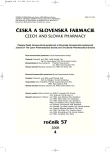Monitoring of pharmacotherapy in seniors of rest homes in Brno region
Authors:
L. Bartošíková 1; J. Nečas 1; T. Bartošík 2; J. Fráňová 3
Authors place of work:
Univerzita Palackého v Olomouci, Lékařská fakulta, Ústav fyziologie
1; Fakultní nemocnice U sv. Anny v Brně, Anesteziologicko-resuscitační klinika
2; Fakultní nemocnice Brno, Dětská nemocnice, II. dětská klinika
3
Published in the journal:
Čes. slov. Farm., 2008; 57, 181-186
Category:
Excerptum
Summary
Polypharmacy is a problem of growing importance in today’s medicine. It has many negative impacts on the patient and healthcare system alike. Seniors with multiple co-morbidities are more likely to be on multiple medications, and therefore they are at higher risk of developing serious side effects or interactions. The aim of the study was to monitor pharmacotherapy of seniors in the rest homes in the Brno region. The study included 72 patients, 26 men and 46 women, of the average age of 84.9 years. Polypharmacy was detected in 92% cases. The number of the most widely prescribed drugs which were medicated in 10 or more patients is 13. Drug interactions are risk of pharmacotherapy but it is possible to avoid them by reduction of polypharmacy.
Key words:
polypharmacy – seniors – drug interactions
Zdroje
1. Endoh, M.: Cardiovasc. Drug. Ther., 2001; 15, 379–403.
2. Flesch, M., Erdmann, E.: Cardiovasc. Drug. Rev., 2001; 15, 379–386.
3. Cheb, P. D., Bhatt, D. I., Topol, E. J., Oral, G. P.: Cardiovasc. Drug., 2001; 6, 421-428.
4. Plevová, J., Boleloucký, Z.: Psychofarmakoterapie vyššího věku, 2. vyd. Praha, Grada Publishing, 2000, s. 164.
5. Topinková, E.: Geriatrie pro praxi, 1. vyd. Praha, Galén, 2005, s. 270.
6. Motlová, L., Holub, D.: Remedia, 2005; 6, 514–516.
7. Záboj, Z.: Prakt. Lék., 2000; 2, 99–101.
8. Novotný, T.: Medical Tribune, 2005; 16, 9.
9. Strojil, J., Horák, F., Arge, J.: Klin. Farmakol. farm., 2007; 1, 43–45.
10. Alušík, Š.: Vnitř. Lék., 1999; 5, 315–318.
11. Gruberová, B.: Gerontologie, 1. vyd. České Budějovice, Jihočeská univerzita, Zdravotně sociální fakulta, 1998, s. 86.
13. Kriška, M. et al.: Memorix klinickej farmakologie, 1. vyd. Bratislava, Slovac Academic Press, 2002, s. 897.
14. Kriška, M. et al.: Riziko liekov v medicínskéj praxi. 1. vyd. Bratislava, Slovak Academic Press, 2000, s. 474.
15. Hegyi, L.: Geriatria, 2005; 2, 78–82.
16. Křivohlavý, J.: Prakt. Lék., 2000; 5, 272–275.
17. Katzung. B. G.: Základní a klinická farmakologie, 2. vyd. Praha, Nakladatelství a vydavatelství H & H, 1995, s. 1072.
18. Bertilsson, L., Dahl, M. L., Dalen, P., Al-Shurbaji, A.: Brit. J. Clin. Pharmacol., 2002; 53, 111–122.
19. Bultas, J., Doležal, T.: Remedia, 2001; 2, 157–161.
20. Michalets, E. I.: Pharmacotherapy, 1998; 1, 84–112.
21. Fialová, D., Topinková, E.: Remedia, 2005; 4–5, 410–417.
22. Topinková, E., Fialová, D.: Postgrad. Med., 2002; 4, 477–482.
23. Baštecký, J. et al.: Gerontopsychiatrie, 1. vyd. Praha, Grada Avicenum, 1994, s. 320.
24. Gates, J. D.: Long term network: EDA 313-0198, 2000.
Štítky
Farmácia FarmakológiaČlánok vyšiel v časopise
Česká a slovenská farmacie

2008 Číslo 4
Najčítanejšie v tomto čísle
- Prof. MUDr. Jaroslav Dršata, CSc. – 65 let
- Aktuální acidita prostředí a účinnost pomocných látek používaných k protimikrobní stabilizaci léčivých přípravků připravovaných v lékárnách
- Zhodnocení farmakoterapie u geriatrických pacientů ve vybraných domovech důchodců v regionu Brno
- Z činnosti farmaceutických společností
